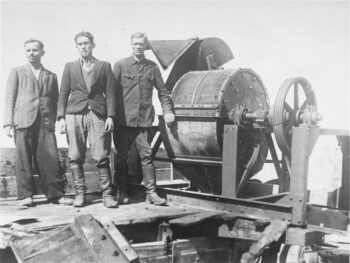Korn, Moische
Moische Korn was a Jew who claimed to have been forced by German units in 1943 to exhume mass graves near the city of Lviv, and to burn the extracted bodies on pyres within the context of what today’s orthodoxy calls Aktion 1005. He escaped from that unit on 19 October 1943.
In a rather generic statement of 13 September 1944 to Soviet investigators, Korn made claims that are partially at odds with those made by the other two witnesses to this alleged event, Heinrich Chamaides and Leon Weliczker.
Korn claimed that the pyres he built measured “10 x 10 x 10 meters,” which can be dismissed safely as a vast exaggeration, as proper pyres for open-air incinerations are usually only one body-length wide and up to 2 m high. Building and maintaining the burning of anything bigger is too challenging and impractical: Did the inmates have a crane to get bodies and wood onto layers more than 2 meters off the ground? And how did they prevent this huge pile, which inevitably burned unevenly, from toppling over, spilling embers, burning wood and partially burned body parts all over the place?

Korn said nothing about where exactly this event occurred nor how many bodies were “processed.” If we assume the number claimed by the orthodoxy (based on Heinrich Chamaides’s account), then 120,000 had to be burned on pyres. Cremating an average human body during open-air incinerations requires some 250 kg of freshly cut wood. Cremating 120,000 bodies thus requires some 30,000 metric tons of wood. This would have required the felling of all trees growing in a 50-year-old spruce forest covering almost 67 hectares of land, or some 149 American football fields. An average prisoner is rated at being able to cut some 0.63 metric tons of fresh wood per workday. To cut this amount of wood within the six months (160 days) that this operation supposedly lasted would have required a work force of some 300 dedicated lumberjacks just to cut the wood. Korn claimed his unit consisted only of 120 inmates, all busy digging out mass graves, extracting bodies, building pyres, sifting through ashes, scattering the ashes, refilling the graves with soil, and planting them with grass seeds and saplings. He said nothing about where the firewood came from.
Korn moreover claimed that all bones were ground by a special mill. However, this alleged mill later turned out to have been a road-building device to crush gravel. Since most inmates from the Janowska Camp were deployed in building roads, this is what this machine was used for. A photo taken by a Soviet investigative commission shows Korn with two more witnesses (Heinrich Chamaides and David Manusevich) standing next to the claimed machine. This shows that at least these three witnesses knew each other and collaborated as a group with the Soviet commission, meaning that their testimonies were probably harmonized and orchestrated to some degree.
(See the entry on bone mill; for more details, see Mattogno 2022c, pp. 515f.)

You need to be a registered user, logged into your account, and your comment must comply with our Acceptable Use Policy, for your comment to get published. (Click here to log in or register.)